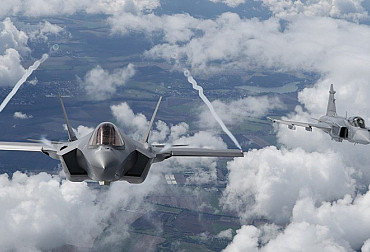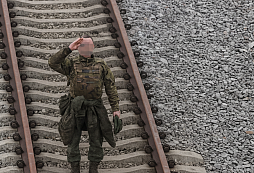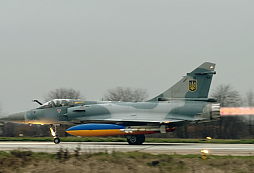Jussi Halmetoja: The choice of aircraft is defined by the needs of the military
The Czech Air Force currently operates 12 JAS-39C Gripen aircraft and 2 JAS-39D Gripen two-seat trainers within the 211th Tactical Squadron in Čáslav. The aircraft were originally procured only in the Air Policing configuration. However, the operational capabilities of the Czech Gripens have been gradually increased and in March 2018, their modernisation was completed, which included, among other things, the integration of laser-guided bombs and targeting containers. As part of the upcoming modernisation of the supersonic tactical air force of the Czech Air Force, negotiations have been ongoing since last July between the Ministry of Defence, headed by Jana Černochová, and the US government on the possible future purchase of 24 F-35A Lightning II multi-role fighter aircraft to replace the leased JAS-39C/D Gripen aircraft. In connection with the Gripen fighter aircraft capabilities, this time we invited Jussi Halmetoja, a former Gripen test pilot and advisor to Saab AB, to our CZ DIALOGY discussion programme, who participated in the expert symposium "Technology and Defence Strategy of the Czech Republic" this spring.
Video: Interview with former Gripen test pilot and Saab AB advisor Jussi Halmetoja / CZ DEFENCE
Jussi Halmetoja is an experienced pilot who has spent more than 24 years in the fighter aviation, during which he has accumulated more than 2,300 flight hours in more than 20 different types of aircraft. Most of his flying experience has been spent in various roles and mission types on Viggen and Gripen aircraft. He served as an armament instructor in the Gripen Operational Test and Evaluation Unit, where he was instrumental in the integration of weapons and sensors during the introduction of these C/D aircraft into the Swedish Air Force's armament. In 2007 he moved to the Gripen Flight Test Centre at the Swedish Defence Materiel Administration. During this time, he also trained at the US National Test Pilot School in Mojave, California, and the US Naval Test Pilot School in Patuxent River, Maryland. After his test period, Jussi was assigned to the International Joint Programme Office Meteor of the British Ministry of Defence as the Swedish representative, where he worked closely on requirements, acceptance and export related matters. On his return, he served as requirements manager for the Gripen E aircraft and was also appointed as the senior national representative for all Gripen air-to-air missile programmes.
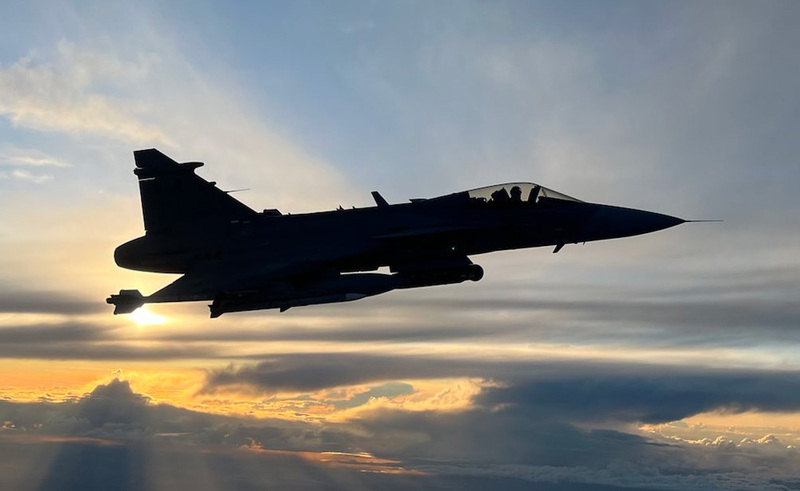 Picture: The Czech Air Force currently operates 12 JAS-39C Gripen aircraft and 2 JAS-39D Gripen two-seat trainers within the 211th Tactical Squadron in Čáslav. | 21. zTL
Picture: The Czech Air Force currently operates 12 JAS-39C Gripen aircraft and 2 JAS-39D Gripen two-seat trainers within the 211th Tactical Squadron in Čáslav. | 21. zTL
"I think we are approaching 17-18 years of service in the Czech Air Force, which means that the Gripens are about halfway through their service life. With every combat capability we have a modernisation programme. We are currently in the next phase of modernisation to increase the capability of the aircraft. The Swedish Air Force plans to fly the Gripen C until at least 2035 and possibly longer. We are introducing improved radar, more powerful electronic warfare and improved weapons capabilities." We wondered how close the Gripen C is to the next generation Gripen E aircraft under all the upgrades. Jussi admits that the similarity of the two aircraft types is perhaps a marketing weakness of the Gripen: "But inside the two aircraft are completely different, with completely different new sensors and completely new capabilities, even though they look the same. We're bringing new capabilities and the key element is linking everything together. That's how we're creating a combat capability for the next generation. The Swedish Air Force is already doing studies and has ambitions to link Gripen C and Gripen E aircraft with their similar network systems and everything that is needed in terms of logistics and other aspects. The transition will be very smooth and functional," says Jussi Halmetoja, who as a former test pilot has experience with both generations of the aircraft and can thus compare the C and E types. "I would like to focus on two different aspects. Firstly, from a pilot's point of view, both aircraft are very similar when it comes to using the cockpit, even though the individual cockpits differ. For me as a pilot, moving to the E type means access to more fuel, more power, more speed, longer range and more flight time. That's the first aspect. The second aspect is tactical operations and what I can do with this new capability, such as the new radar and high-end electronics. We bring the best available options for electronic warfare. The important thing is how all these sensors and capabilities interact with different versions of the Gripen and different platforms. This is how combat air capability is created today - by networking, rather than by speed or altitude of flight," points out Jussi Halmetoja, who says the controls are also similar in both generations of Swedish aircraft. The flight mechanics and controls are very similar and this is true for most aircraft and aviation platforms around the world. "The challenge is transitioning from one type of aircraft to another and gaining access to the new capabilities that advanced technology brings," thinks the former Gripen test pilot.
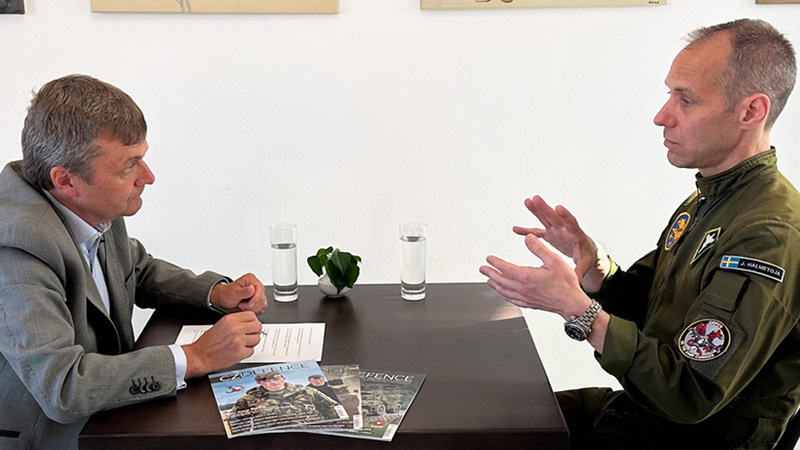 Picture: In this episode of our discussion show CZ DIALOGY we talked to former Gripen test pilot and Saab AB advisor Jussi Halmetoja | Michal Pivoňka / CZ DEFENCE
Picture: In this episode of our discussion show CZ DIALOGY we talked to former Gripen test pilot and Saab AB advisor Jussi Halmetoja | Michal Pivoňka / CZ DEFENCE
5th generation technology is a term that is increasingly being bandied about in negotiations for the acquisition of new aircraft for the Czech Armed Forces. Jussi Halmetoja thinks that more important than the technology itself is the actual capability that the technology brings. Aircraft generations should be seen more as a list of different technologies and features that affect the appearance and behaviour of the aircraft. "What is more important is the capability of the aircraft and what the technology enables rather than the technology itself," explains the former test pilot, who believes that the new Gripens can perform all missions just like the fifth-generation aircraft, even if they don't have all the features and technology of the fifth generation. "When comparing different aspects, it is important to ask what is really important. Whether the technology itself is more important or what the technology brings in the form of capabilities. We focus on the capabilities of the aircraft and what they are designed to do. For example, the F-35 has great capabilities as a multi-role fighter. Its mission is to participate in joint defence, support, direct protection warfare and to attack a target over enemy territory with medium- and short-range missiles," Halmetoja says, elaborating on the need to ask what kind of mission a particular country is interested in. "Is this a mission for the Swedish armed forces or not? Is it going to be a mission for the Czech air force that intends to bomb somewhere? The Gripen has been designed for air combat missions, air surveillance missions and protecting a country's borders. It's about your doctrine, your concept, your core mission for that platform. It's also important to consider the strengths and weaknesses of any platform in light of these factors," points out key decision maker Jussi Halmetoja.
In general, the main parameter for selecting the right machine is the definition of needs and capabilities by the Army. "Capabilities can be categorised in a simple way, but above all they are the requirements of a specific country, i.e. the requirements and concepts of the Czech Armed Forces, the Czech nation and the Czech Air Force. And what is the key mission? Only the Czech Air Force can answer this question, but I think it is the guarding of airspace. The other thing is the survivability, how to defend against all threats. It is also about effectiveness, i.e. weapons and electronic warfare, kinetic and non-kinetic effectiveness. Without weapons, the aircraft is worthless. It is also about flexibility, the ability to get out of any location, from its base in Čáslav, etc. Then there are other things like availability. If you don't have available aircraft, you can't fight, and this applies to aircraft on the air base that are already in the air, aircraft that are ready to fly, and aircraft that are in a state of maintenance. Training is also very important," Jussi Halmetoja, a former combat and experienced pilot and air capability advisor at Saab Aeronautics, says in an interview.
If you want to know more about the capabilities of the JAS-39 Gripen, listen to the full interview with former Gripen test pilot and Saab AB advisor Jussi Halmetoja at the top of this article.















